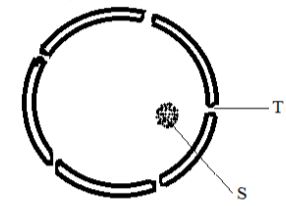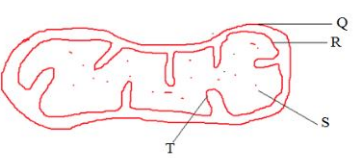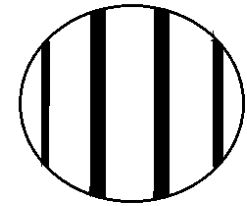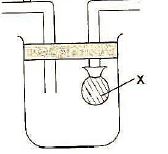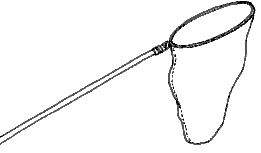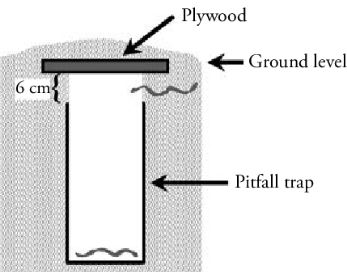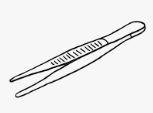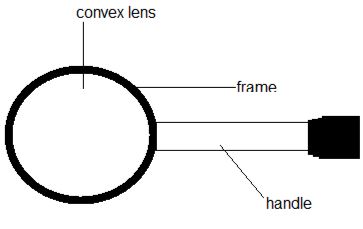- State two advantages of using a coverslip when preparing a specimen for observation using the light microscope. (2mks)
- The diagram below is a nucleus.
- What is the function of a nucleus? (1mk)
- Name the structure labeled T and S. (2mks)
T –
S – - State the function of part T. (1mk)
- How are the following specialized cells specialized for their functions?
- Root hair cell. (1mk)
- Nerve cell (1mk)
- Muscle cell. (1mk)
- Define the following terms.
- Organ. (1mk)
- Organ system (1mk)
- Arrange the following from the smallest to the largest (1mk)
Cell, organ, tissue, organ system, organelle, organism; - State the function of the following tissues. (2mks)
- Parenchyma tissue. (1mk)
- Epithelial tissue (1mk)
-
- What is the purpose of the following during preparation of temporary slide.
- Cutting thin sections. (1mk)
- Using a sharp razor blade (1mk)
- Staining (1mk)
- Name two commonly used stains. (2mks)
- What is the purpose of the following during preparation of temporary slide.
- Name the parts labeled Q, R, S and T in the diagram below. (4mks)
- In a class experiment to establish the size of onion cell, a learner observed the following on the microscope field of view.
If the student counted 20 cells across the diameter of the field of view, calculate the size of one cell in micrometers. ( 3mks) - State the function of the following parts of a microscope.
- Diaphragm. (1mk)
- Mirror. (1mk)
-
- Explain what is meant by haemolysis. (1mk)
- Three potted plants were dipped in solutions of potassium ions at different concentrations of oxygen. Below is a table showing how potassium ions were absorbed at different percentages of oxygen concentration.
Explain the relationship between oxygen concentration and absorption of potassium ions (3mks)Percentage concentration of oxygen 3.7 15 21 Relative absorption of potassium ions 22 96 100 - The study of biology enhances international cooperation, as countries work together to solve environmental problems. Name two biology related international conventions that help solve environmental problems. (2 marks)
- Name the field of science that specializes in the study of chemical substances in an organism and the reactions in which they take part. (1mk)
- The specific name of mango tree is Indica and its genus name Mangifera
- State one mistake in the way the specific name is written. (1mk)
- Write the name in the correct manner following the rules of the binomial nomenclature. (1mk)
- A scientist discovered a new organism and decided to assign it a scientific name. What rules should be put in consideration while assigning the name? (4mks)
- Draw and state the function of the following apparatus: (8mks)
- Pooter
- Sweep net-
- Pitfall trap
- Pair of forceps
- Complete the table below (5mks)
Branches of biology Description Study of inheritance and variation Study of cells Anatomy Study of living organisms in their surroundings; -
- What is the formula for calculating magnification of a specimen when using a hand lens (1mk)
- Draw and label a hand lens (4mks)
- State the importance of the following characteristics of living things (3mks)
- Respiration
- Reproduction
- Locomotion
- Explain the factors that affect the process of diffusion. ( 20 mks)
MARKING SCHEME
- State two advantages of using a coverslip when preparing a specimen for observation using the light microscope. (2mks)
- Hold the specimen in position;
- Protect the specimen from dehydration/ drying up/dust particles;
- Protect the objective lens from staining;
- The diagram below is a nucleus.
- What is the function of a nucleus? (1mk)
- Control all the activities of a cell.
- Name the structure labeled T and S. (2mks)
T– Nuclear pore;
S – Nucleolus; - State the function of part T. (1mk)
- Facilitate movement of materials in and out of the nucleus;
- What is the function of a nucleus? (1mk)
- How are the following specialized cells specialized for their functions?
- Root hair cell. (1mk)
- Has an extension which increases the surface area for absorption of water and mineral slats;
- Nerve cell (1mk)
- Have extensions called axons and dendrites that facilitate impulse transmission;
- Muscle cell. (1mk)
- Contain contractile fibrils that contract and relax bringing about movement;
- Root hair cell. (1mk)
- Define the following terms.
- Organ. (1mk)
- Distinct part of an organism that consists of a group of tissues specialized to perform a specific function;
- Organ system (1mk)
- Several organs whose functions are co-ordinated and synchronized to realize an effective function in a living organism.
- Arrange the following from the smallest to the largest (1mk)
Cell, organ, tissue, organ system, organelle, organism;- Organelle, cell, tissue, orgn, organ system, organism;
- State the function of the following tissues. (2mks)
- Parenchyma tissue. (1mk)
- Form packaging and storage sites;
- Epithelial tissue (1mk)
- Protection of internal and external surfaces;
- Parenchyma tissue. (1mk)
- Organ. (1mk)
-
- What is the purpose of the following during preparation of temporary slide.
- Cutting thin sections. (1mk)
- Allow light to penetrate/pass through;
- Using a sharp razor blade (1mk)
- Prevent distortion of the specimen;
- Staining (1mk)
- Make structure within the specimen more distinct;
- Cutting thin sections. (1mk)
- Name two commonly used stains. (2mks)
- Iodine solution; reject iodine alone.
- Eosin safranin;
- Methylene blue;
- Haematoxylene
- Fast green;
- What is the purpose of the following during preparation of temporary slide.
- Name the parts labeled Q,R,S and T. (4mks)
Q- Outer membrane;
R – Inner membrane;
S –matrix
T – Cristae; - In a class experiment to establish the size of onion cell, a learner observed the following on the microscope field of view.
If the student counted 20 cells across the diameter of the field of view, calculate the size of one cell in micrometers. ( 3mks)
Size of one cell = Diameter of field of view ;
Number of cells
= 4mm x 1000um;
20 cells
= 200um - State the function of the following parts of a microscope.
- Diaphragm. (1mk)
- Regulate the amount of light entering the stage;
- Mirror. (1mk)
- Reflect light to the stage;
- Diaphragm. (1mk)
-
- Explain what is meant by haemolysis (1mk)
- Bursting of the red blood cell;
- Three potted plants were dipped in solutions of potassium ions at different concentrations of oxygen. Below is a table showing how potassium ions were absorbed at different percentages of oxygen concentration.
Percentage concentration of oxygen 3.7 15 21 Relative absorption of potassium ions 22 96 100 - Explain the relationship between oxygen concentration and absorption of potassium ions (3mks)
- As the concentration of oxygen increases the higher the relative potassium absorption, oxygen is required in respiration; to release energy needed in potassium ion absorption (active transport);
- Explain what is meant by haemolysis (1mk)
- The study of biology enhances international cooperation, as countries work together to solve environmental problems. Name 2 biology related international conventions that help solve environmental problems. (2 marks)
- Kyoto Protocol; Convention on International Trade in Endangered Species.
- Name the field of science that specializes in the study of chemical substances in an organism and the reactions in which they take part. (1mk)
- Biochemistry;
- The specific name of mango tree is Indica and its genus name Mangifera
- State one mistake in the way the specific name is written. (1mk)
- The name Indica should start with small letter I;
- Write the name in the correct manner following the rules of the binomial nomenclature. (1mk)
- Mangifera indica;
- State one mistake in the way the specific name is written. (1mk)
- A scientist discovered a new organism and decided to assign it a scientific name. What rules should be put in consideration while assigning the name? (4mks
- The first name should be the generic name and the second name is the specific name (1mk
- The generic name should start with a capital letter while the specific name should start with a small letter
- The names should be printed in italics or underlined separately when handwritten (1mk
- The names should be in Latin Language or Latinised
- Draw and state the function of the following apparatus: (8mks)
- Pooter - Used for collecting insects
- Sweep net - Sweeping insects out of riparian vegetation
- Pitfall trap - Trapping small animals such as insects
- Pair of forceps - Grasp and holds objects for stability.
- Pooter - Used for collecting insects
- Complete the table below (5mks)
Branches of biology Description Parasitology Study of parasites Genetics Study of inheritance and variation Cytology; Study of cells Anatomy Study of external structures of organisms Ecology; Study of living organisms in their surroundings; -
- What is the formula for calculating magnification of a specimen when using a hand lens (1mk)
Magnification = drawing linear length
Actual length of the specimen - Draw and label a hand lens (4mks)
3marks –labelling
1mk- drawing
- What is the formula for calculating magnification of a specimen when using a hand lens (1mk)
- State the importance of the following characteristics of living things (3mks)
- Respiration
- Production of energy required by the living thigs
- Reproduction
- Production of new organisms of the same kind as parents
- Prevent extinction of species
- Improvement of species especially in sexual reproduction
- Locomotion
- Escape unfavourable conditions
- Get nutrients/food
- Get mates
- Respiration
- Explain the factors that affect the process of diffusion. ( 20 mks)
- Concentration gradient; the higher/greater the concentration gradient between two regions; the higher/faster rate of diffusion; and converse.
- Size of the molecules; smaller; and lighter molecules; diffuse faster; than larger and heavier molecules which diffuse slowly;
- Temperature ; as temperature increases; the rate of diffusion increases; when the temperature is low the rate decreases;
- Thickness of the membrane/tissue; in thin membranes/tissue; the rate of diffusion is faster; than in thick membranes(where it’s slow).
- Medium in which it is taking place; it is faster in air; since molecules are far apart; than in water and solids; where molecules are closer ;
- Surface area to volume ratio; the higher the ratio; the faster the process of diffusion/the shorter the distance covered by diffusing molecules; the lower the ratio; the slow the rate of diffusion;
- Surface area; the larger the surface area the faster the rate of diffusion and converse;
Join our whatsapp group for latest updates
Tap Here to Download for 50/-
Get on WhatsApp for 50/-
Download Biology Questions and Answers - Form 1 Term 3 Opener Exams 2023.
Tap Here to Download for 50/-
Get on WhatsApp for 50/-
Why download?
- ✔ To read offline at any time.
- ✔ To Print at your convenience
- ✔ Share Easily with Friends / Students

